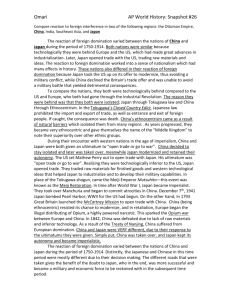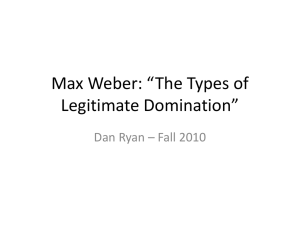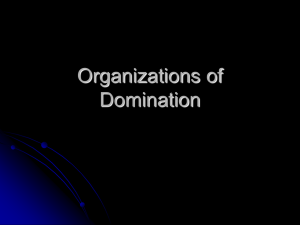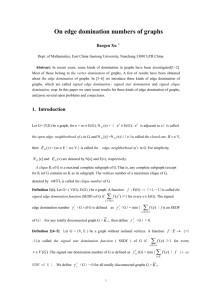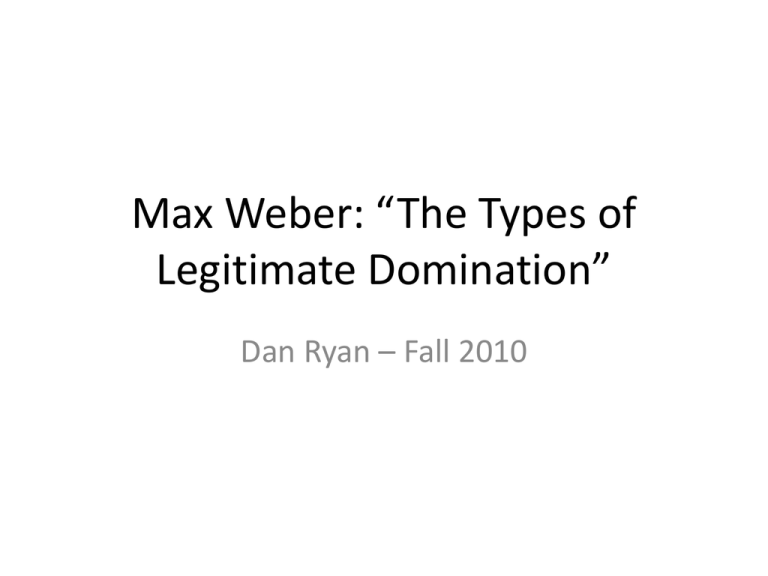
Max Weber: “The Types of
Legitimate Domination”
Dan Ryan – Fall 2010
1. Domination = probability command(s) will be
obeyed. Subtype of power and influence. Wide
variation in basis. Always a measure of
“voluntary compliance”
2. D of groups takes staff. Staff obey from custom,
affect, pay, or ideals & this determines type of
domination. But legitimacy also needed.
3. D rarely relies on custom, affect, or pay alone.
Everything about social organization of D seems
to depend on basis of legitimacy claim.
Legitimacy
• http://en.wikipedia.org/wiki/Legitimacy_%28
political%29
4. Legitimacy is a reasonable basis for
classifying types of domination.
5. Authority relationship is a broad category.
6. Mere “power over” not same as authority. A
involves command and obedience. But there
are gradations in real world.
7. People obey for different “real” reasons.
What’s important is how basis for validity of
authority is related to “means of its exercise.”
8. Even in regime with no legitimacy vis a vis
subjects, authority relation between leader
and staff will be classifiable.
9. Obedience = action follows content of
command without regard to actor’s own
stance.
10. Subjective process in actor not relevant
here.
11. Effects of domination as social phenomenon
extend throughout society.
12. Ideology of “leader as servant” does not
change this analysis.
13. Three types of basis for legitimate authority:
rational; traditional; charismatic.
14. Rational = legal authority based on rules.
15.Traditional = based on belief in sanctity of
“the way it’s always been done.”
16. Charismatic = based on exceptional
character of an individual
17. Variations across types in person obeyed and
what determines range of things covered.
Influence
Power
Authority
Economy and Society
•
Part One: Conceptual Exposition
I. Basic Sociological Terms
II. Sociological Categories of Economic Action
III. The Types of Legitimate Domination
IV. Status Groups and Classes
212
302
Part Two: The Economy and the Arena of Normative and De
Facto Powers
I. The Economy and Social Norms
II. The Economic Relationships of Organized Groups
III. Household, Neighborhood and Kin Group
IV. Household, Enterprise and Oikos
V. Ethnic Groups
VI. Religious Groups (The Sociology of Religion)
VII. The Market: Its Impersonality and Ethic (Fragment)
Volume 2
VII. Economy and Law (The Sociology of Law)
IX. Political Communities
X. Domination and Legitimacy
XI. Bureaucracy
XII. Patriarchalism and Patrimonialism
XIII. Feudalism, Ständestaat and Patrimonialism
XIV. Charisma and Its Transformation
XV. Political and Hierocratic Domination
XVI. The City (Non-Legitimate Domination)
THE TYPES OF LEGITIMATE DOMINATION
1. THE BASIS OF LEGITIMACY
Domination and Legitimacy
The Three Pure Types of Authority
2. LEGAL AUTHORITY WITH A BUREAUCRACATIC
ADMINISTRATIVE STAFF
Legal Authority, The Pure Type
Monocratic Bureaucracy
3. TRADITIONAL AUTHORITY
4. CHARISMATIC AUTHORITY
5. THE ROUTINIZATION OF CHARISMA
6. FEUDALISM
7. TRANSFORMATION OF CHARISMA IN A DEMOCRATIC DIRECTION
8. COLLEGIALITY AND THE DIVISION OF POWERS
9. PARTIES
10. DIRECT DEMOCRACT and REPRESENTATIVE ADMINISTATION
11. REPRESENTATION
Class, Status, and Party
1.
2.
3.
4.
5.
6.
7.
8.
9.
10.
Economically Determined Power and the Status
Order (119.3)
Determination of Class Situation by the Market
Situation (119.9)
Social Action Flowing From Class Interest (121.2)
Types of Class Struggle (122.1)
Status Honor (123)
Ethnic Segregation and Class (124.8)
Status Privileges (126.2)
Economic Conditions and Effects of Status Stratification
(126.9)
11. Parties (128.4)

